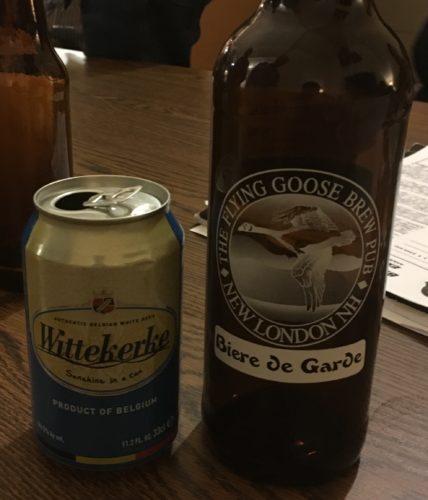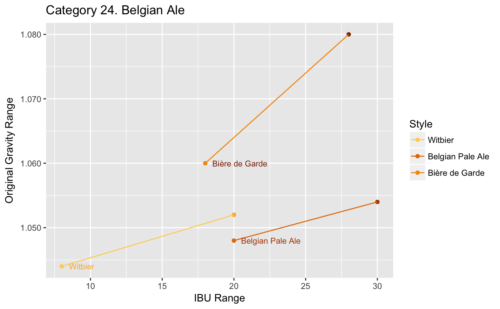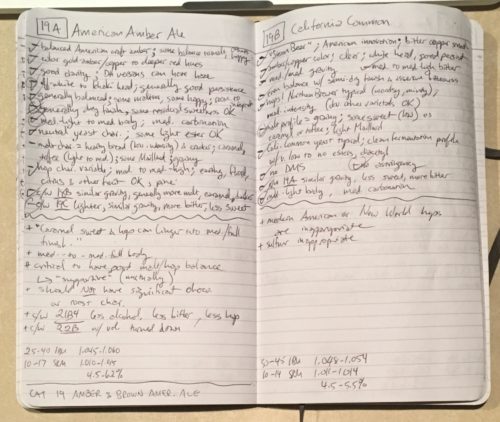BJCP Study Group: Category 24
¶ by Rob FrieselOur twenty-fourth and final session covered the Belgian Ales.
Category 24. Belgian Ale
I’ll admit it, I did a poor job of preparing for this one. The originally scheduled date for the study group (April 26) was one where I was out of town on vacation. 1 Combine that with the fact that most of these styles are hard to find around here… I knew I’d need to know them for the exam but I also figured that I could fit that in around the edges.
Regardless…
This category contains the maltier to balanced, more highly flavored Belgian and French ales.
| 24A. Witbier | 24B. Belgian Pale Ale | 24C. Bière de Garde |
|---|---|---|
| 8 – 20 IBU | 20 – 30 IBU | 18 – 28 IBU |
| 1.044 – 1.052 O.G. | 1.048 – 1.054 O.G. | 1.060 – 1.080 O.G. |
| 1.008 – 1.012 F.G. | 1.010 – 1.014 F.G. | 1.008 – 1.016 F.G. |
| 4.5 – 5.5% ABV | 4.8 – 5.5% ABV | 6.0 – 8.5% ABV |
Again, my style study notes on these aren’t great, but a few broad-strokes: all three should be flavorful and smooth; “honey” is a descriptor that tends to come up quite a bit; spicy and/or herbal and/or floral hop characteristics are also common, though typically in relatively low amounts.
All three should have a pretty different yeast expression. Witbier should have fairly pronounced yeast character with a citrusy ester typical. Belgian Pale Ale should have a similar ester, though orange or pear-like, but not as high in more “typical” Belgian styles (i.e., not aggressive). Meanwhile, the Bière de Garde should be almost lager-like.
- 24A. Witbier. Wittekerke by Brouwerij De Brabandere. Judged/scored; structured tasting. Group scores converged in the 30s, though were spread from 32 to 39, mostly on the lower end. While an enjoyable beer, it seemed too clear for the style, was missing the characteristic coriander, and slightly under-carbonated. A bunch of discussion around how we individually arrived at our scores. A bunch of discussion around how much weight to give to “characteristic” ingredients that are not (strictly speaking) listed as required.
- 24C. Bière de Garde. Flying Goose Bière de Garde. Judged/scored; structured tasting. Barrel-aging and a strong Brett. character nudged most of us into scoring it in the high-teens or low-20s. A common refrain: “I enjoyed it, it just wasn’t to-style as a Bière de Garde.” The funky Brett. character and the strong oak barrel tannins washed out everything else about it that might have been a Bière de Garde. Again: enjoyable, just not to-style.
- Scoring lightning round. Given that the Noonan competition was just a few days ago, we had access to some of the left-over beers. We picked one in particular and did a lightning round of scoring on it. The idea was that, in five minutes or fewer, we should all be able to write down some quick impressions, jot down a score, and then we could compare it to what was actually issued as the consensus score by Certified (or better) judges, just a few days ago. We clustered around 35. Typical comments included: “Malt backbone seemed like an after-thought. Hops were present but didn’t come together. Thin in the body.” Though collectively we were clustered, we were also collectively a bit high. This beer had received a score in the high-20s — BUT it was also something like beer #7 in a flight of 9, giving us a sense of how palate fatigue could factor into our judging and scoring.
- Bonus beers. A maple bourbon barrel-aged imperial stout. A “Blonde Abbey” ale (saison grist + Sorachi Ace hops + Trappist yeast). A buckwheat + spelt saison.
Wrapping Up
Though I’m sure there were still more takeaways from this session, it was time to put a pin in it. Our exam is just over a week away, and we’ve covered all the styles. What else is left?
We spent the last few minutes of the study group going over some notes to help us prepare for the exam itself. We talked about the format, what kind of beers we might expect, and what kind of range of flaws and scores etc. we should be expecting. We probed each other on how thorough we felt we could make our sensory descriptions. We talked about strategies for remembering all the things that needed to go onto the scoresheets.
I showed off my “self-study” notebook where I’ve been writing down from memory everything I can about a style (with special emphasis on overall impression and style comparisons) and then cross-validating it against the style guidelines. This exercise has been challenging, rewarding, tedious, and humbling. And I recommend it to everyone studying for the exam.
We’re very nearly there.
- Turns out that that study group was re-allocated to help out with the 2018 Noonan Competition pre-judging. I was bummed to miss that too, but given that I’d gotten to judge at the 2017 Champlain Valley Fair… I called it even.[↩]
About Rob Friesel
Software engineer by day. Science fiction writer by night. Weekend homebrewer, beer educator at Black Flannel, and Certified Cicerone. Author of The PhantomJS Cookbook and a short story in Please Do Not Remove. View all posts by Rob Friesel →3 Responses to BJCP Study Group: Category 24
Pingback: Homebrew #78: Le Rousse (Ambrée Bière de Garde) | found drama



Leave a Reply